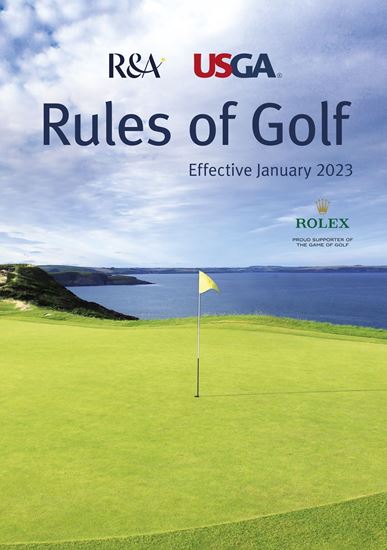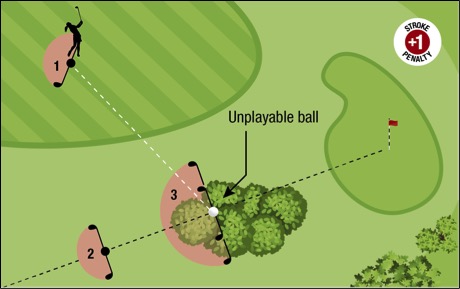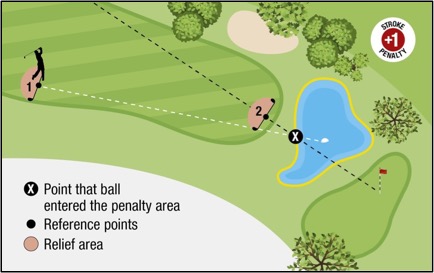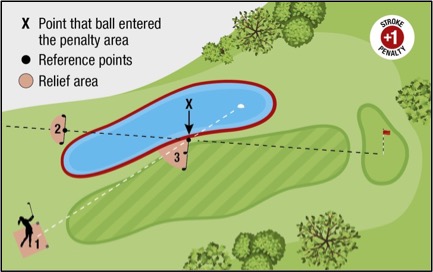
Rules of Golf
The Player’s Edition of the Rules of Golf is available via the R&A Rules App, or you can find video explanations at www.rules.golf (R&A Rules Modernisation), or on YouTube (just search for “New Golf Rules” and you will get several versions).
Here’s a reminder of some of the rules we use most frequently, followed by explanations of what to do if your ball is unplayable or has landed in a penalty area, and lastly a copy of the local rules for our course (also on the back of the scorecard).
See if you think you know the rule before clicking to expand it.
Rules Reminders
On the green, the flagstick can be:
left in while putting, or taken out, or tended. There is no penalty for hitting the flagstick.
Damage on the green can be:
repaired, anywhere on the green, before you putt.
If your ball moves on the green before you putt because you accidentally hit it or due to wind:
replace it where it was before it moved, for no penalty.
You can search for a lost ball for a maximum of:
3 minutes.
You can lift, clean and drop an embedded (plugged) ball if it is:
anywhere on the course except in a bunker, as long as it is in its own plug mark and at least part of the ball is below the surface of the ground
If you decide your ball in a bunker is unplayable you can:
drop elsewhere in the bunker (one penealty stroke) or out of and behind the bunker (two penalty strokes)
When you drop the ball (either free or for penalty) it must:
be from knee height, land in and come to rest in your relief area. See below for more information on dropping and relief areas.
Double hitting the ball or hitting yourself/your partner/you or your partner's equipment is:
not a penalty. But it’s probably a good idea not to hit your partner on purpose.
Loose impediments (unattached natural objects eg stones, leaves, animal waste, worms/casts) may be moved:
without penalty anywhere on the course, but if you accidentally move the ball in the process you get a 1 stroke penalty (except on the tee or green) and you must replace the ball on the original spot.
Abnormal Course Conditions, for which there is free relief, include:
animal holes, GUR (including seeded ground or an area marked by blue posts), immoveable obstructions and temporary water.
If, after your tee shot, your ball is still in the teeing area, you can:
play it as it lies or play it from anywhere else in the teeing area, including teeing it up, without a penalty (though the first tee shot still counts).

Unplayable Ball
This arises quite often if, for example, you have ended up in deep rough or bushes/trees but have found your ball. Here a player has hit a ball from position 1 into some bushes.
You have 3 choices. You can play from position 1 again, you can go back on a line from the flag as far as you like (2) or you can take lateral relief (3). If you decide to do one of the first two, place a tee at the reference point (i.e. where you played the first shot (1) or as far back on a line as you wish (2)). Then, measure 1 club length using your longest club (not a putter) in a semicircle no nearer the hole. This is your relief area. Next, drop your ball from knee height so that it lands in and stays in this relief area.
REMEMBER: knee height not shoulder height and the ball must drop in and stay in the relief area.
For lateral relief (option 3) the reference point is the position of the unplayable ball and the relief area is 2 club lengths to either side, no nearer the hole. So, like the old rule, for lateral relief you must drop the ball within 2 club lengths of the unplayable ball’s position.
For all 3 options you add one penalty stroke to your score for the hole.
REMEMBER: If you played a provisional ball from position 1, because you weren’t sure you would find the first ball, but then you do find it, you then have to play it or take one of the three options above for a penalty drop; you cannot choose to play the provisional ball instead.

Penalty Areas
These are what we used to call water hazards (yellow stakes/lines) and lateral water hazards (red stakes/lines) but are now called Yellow Penalty Areas and Red Penalty Areas. Now, courses can have other areas – not just water or ditches – as Penalty Areas but we don’t have that at Kirkcudbright yet, nor is there any immediate plan to do so. But it is better to start thinking of our ponds and ditches marked with yellow or red stakes/lines as Penalty Areas.
You are allowed to try and play your ball in a Penalty Area if you wish, with no penalty. Also, as a change, you can ground your club and take practice swings in the Penalty Area.
If you do not wish to play your ball in the Penalty Area then you can take a penalty drop out of it. For Yellow Penalty Areas the dropping rules are much the same as before: see the picture above. You still have the option of either playing again from where you played the original shot (see option 1 – “stroke and distance relief”) or somewhere on a line back from where the ball entered the Penalty Area, in line with the flag (“back on a line relief”, see option 2).
The main changes here are the relief area and the drop. When you have decided which to do, place a tee at the reference point i.e. where you played the first shot (1) or as far back on a line from entry to the Penalty Area as you wish (2). Then, measure 1 club length using your longest club (not a putter) in a semicircle no nearer the hole. This is your relief area. Next, drop your ball from knee height so that it lands in and stays in this relief area.
REMEMBER: knee height not shoulder height and the ball must drop in and stay in the relief area. If you don’t do it this way you will end up incurring more penalties!

Red Penalty Area
Red Penalty Area rules have changed slightly more (see Diagram 2 below). Now there are 3 options.
Two of those are the same as the Yellow Penalty Area options: either stroke and distance relief (see option 1 above) or back on a line relief (see option 2 above). For Red Penalty Areas, option 2 has replaced what was called lateral relief on the directly opposite side from the point of entry, which you can no longer do. But really the easiest way to remember options 1 and 2 for Red Penalty Areas is that they are the same as the 2 options for Yellow Penalty Areas. So, for all Penalty Areas, you can take either “stroke and distance” or “back in a line” relief.
Option 3 is the extra option for Red Penalty Areas because you can still take lateral relief on the side the ball entered the Penalty Area (see option 3 above). The reference point is where the ball entered the Penalty Area and the relief area is 2 club lengths (not a putter) in an arc between the edge of the Penalty Area and a point no nearer the hole.
Again, for all these options dropping is from knee height and the ball must land in and stay in the relief area.
In summary: If your ball ends up in a Penalty Area you can either play it or take a one-shot penalty drop. If you choose to drop you can either play the shot again (stroke and distance relief), drop on a line back from the point of entry in line with the flag (back on a line relief) or, for Red Penalty Areas, drop laterally from the point the ball entered the Penalty Area (lateral relief). Mark your reference point, measure your relief area, drop from knee height so that the ball lands in and stays in the relief area.
Local Rules
Rule 8.1a (Boundary Object/Integral Object): all stiles, walls, steps and fences at the boundary of, or within, the General Area; in all cases the ball must be played as it lies.
Rule 15.2 (Movable Obstruction): black & white marker posts on fairwaysv may be moved
Rule 16 (Immovable Obstruction): all setas, litter bins, roads, paths, water fountains and marker poles (other than black & white); free relief may be taken, except in a Penalty Area
Rule 16 (Abnormal Course Conditions): a ball lying on seeded ground (including a divot mark that has been filled with sand and seed) or within an area marked by blue posts in Ground Under Repair and relief must be taken.
Rule 17 (Penalty Areas): all ground or water within the boundary of an area marked by red/yellow stakes/lines is part of the Penalty Area.
Rule 18.2 (Out of Bounds): Out of Bounds is defined by:
a. Any wall or fence on the boundary of the General Area.
b. The fence enclosing the car park and clubhouse and the hedge enclosing the practice putting green.
c. To the left of the white posts between the 5th and 12th fairways, when playing the 12th hole only.
d. The fenced area (Scottish Water installation) between the 5th and 7th holes.
e. The Wildlife Park, bordering the 3rd, 4th, 5th and 7th holes.
Dropping Zones (additional option for relief with penalty)
Ball in pond by 11th green: drop within 2 club lemgths in a semicircle back from the blue stake at the front of the pond.
Ball under hedge by 18th green: drop within 1 club length of the blue disc beyond the ditch to the rear of the green.
Distance Markers
Marker posts are 150 yards to the centre of the green.
